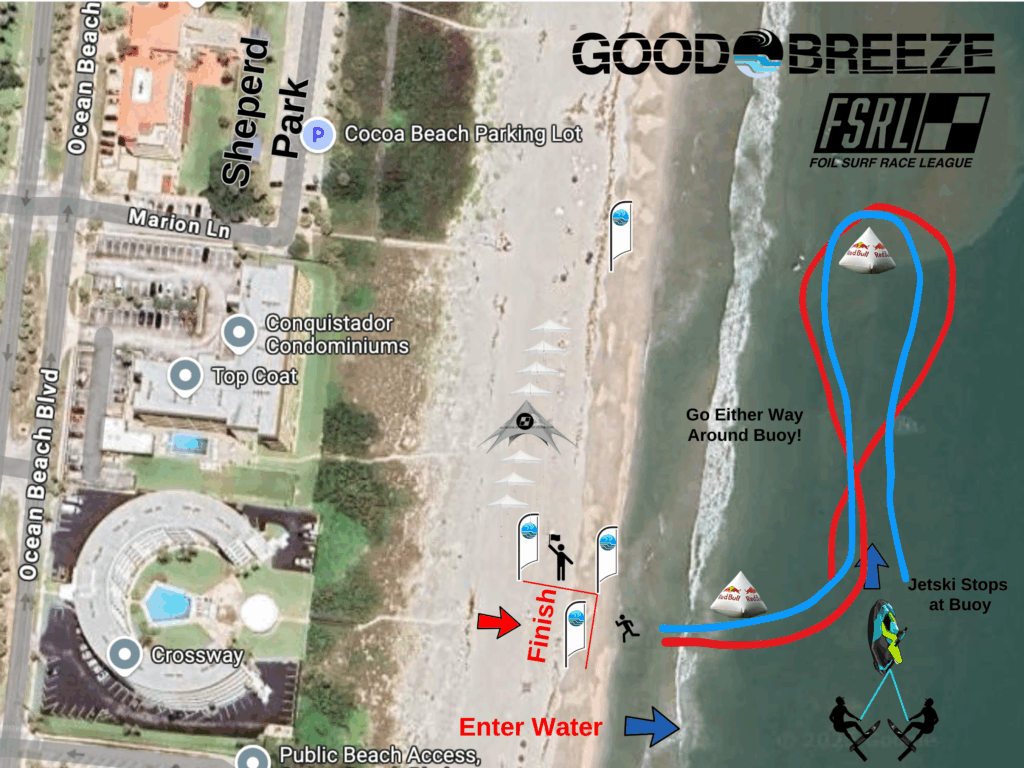FSRL 1V1 Race Rules and Format
Rules for 1v1 format
The FSRL 1v1 format is a PWC assisted foil race that can take place in the ocean or fresh water. It puts two riders head to head against each other. Riders complete the course by pumping their foils and first to cross the finish line wins.
- No restrictions on board, foil or mast size
- No motors or assist is permitted
- No foot straps or hooks can be worn
- Collisions and contact must be avoided at all cost
- Judges will DNF and disqualify anyone intentionally making contact or riding recklessly.
What you need
- The 1v1 course is 90 yards long. Laser sight the length
- Two buoys to set up the course.
- PWC for towing
- Two tow ropes
- Line judge and scorer
How it Works
- To start the race the PWC picks up both riders on the same ski approximately 200ft outside the upstream boundary. Each rider has their own rope, one on the left side one on the right.
- A gentleman’s agreement on who takes which side is made. This can be settled by rock, paper, scissors if both riders prefer the same side.
- The PWC drives directly toward the downstream buoy and lets off power shortly before the upstream boundary so the ski never enters the course.
- The riders both can use the whip of the rope to generate starting speed and start pumping
- The rider in the lead at the downstream turn buoy has the right of way.
- Riders can pump around the down stream buoy either way, clockwise or counter clockwise
- Race Format can have two different variations of finish; 1.) Race ends at the upstream boundary line or 2.) Riders must exit the water and finish at finish line on land if site layout permits.
- First riders to cross the finish line wins.
- If a rider falls on the start, the ski stops and both riders start again. If the rider falls a second time on the start they lose that race.
- Once both riders are up riding, ANY fall, even if the rider isn’t in the course yet results in a DNF (0) for the fallen rider.

Formats
There are three options for this style of racing:
- Head to head single elimination bracket
- Full round robin
- Hybrid round robin
Round Robin. Full
A full round-robin tournament is a type of competition where each riders competes against every other rider at least once. Here are the basic rules for running a round-robin tournament:
- Participants
- Every rider must compete against all other participants.
- Schedule
- Each rider plays against every other participant exactly once (in a single round-robin).
- The number of matches will be equal to the combination of riders
- Matches are scheduled so that each rider faces all other participants.
- Scoring
- Each match awards points based on the result:
- Win: 3 points for a win
- Finish: 1 point for finish
- Loss: 0 points for a fall or DNF
- Each match awards points based on the result:
- Ranking
- After all the matches are played, riders are ranked based on the total number of points accumulated.
- If riders have equal points, tie-breakers are used to determine the ranking.
- Head-to-head record: Compare results of matches between the tied participants.
- Winner
- The rider with the most points at the end of the round-robin tournament is declared the winner.
- If multiple participants are tied for the top spot, tie-breaker rules (as mentioned above) will be used to determine the winner.
- Number of Rounds
- For example, in a 6-player tournament, each player will compete in 5 matches.
- No Eliminations
- Unlike knockout tournaments, no riders are eliminated in a round-robin format. Every rider plays against every other participant.
Example:
In a 4-rider round-robin tournament (A, B, C, and D), the matches would be:
- A vs B
- A vs C
- A vs D
- B vs C
- B vs D
- C vs D
Each rider would play 3 matches. The winner is determined by accumulating the most points based on the match outcomes.
Hybrid
A hybrid round-robin tournament combines elements of round-robin and single-elimination formats. This format starts with a round-robin phase (where each rider plays against all others) and then transitions into a knockout-style single-elimination phase, where only the top rider from the round-robin phase advance.
- Round-Robin Phase
In this initial phase, riders play against each other to determine their ranking.
Participants:
- All riders compete in a round-robin format.
- The number of rider can vary, but ideally, it should be a multiple that can be easily divided into groups (e.g., 8, 16, 32).
Group Division (Optional):
- If the number of participants is large (e.g., 16+), you can divide them into smaller groups. The number of groups depends on the total number of players. For instance:
- 4 groups of 4 players if there are 16 participants.
- 2 groups of 8 players if there are 16 participants (or adjust based on your numbers).
- Each group plays a round-robin, where every rider plays against every other rider in their group.
- Winners of each group advance to single elimination bracket.
Match Format:
- Each participant plays every other participant in their group once.
- For each match, use a scoring system such as:
- Win: 3 points
- Finish: 1 point for a finish
- Loss: 0 points for fall or DNF
Ranking Within Groups:
- Riders are ranked based on the points they earn from all their round-robin matches.
- If there is a tie in points:
- Head-to-head result between tied players.
Advancement to the Elimination Phase:
- After the round-robin phase, the top rider from each group advance to the single-elimination phase.
- The winner from each group advance to the knockout rounds.
- Single-Elimination Phase
The top riders from the round-robin phase move to this phase, which is played in a knockout format.
Bracket Setup:
- The top rider from each group are placed into a single-elimination bracket. The number of players advancing can vary (ideally 4 or 8 riders).
- This phase is a straight knockout: lose once, and you’re out.
Seeding:
- Seeding can be done based on the round-robin results:
Match Format in Elimination Rounds:
- Riders are paired against each other in the following sequence:
- Quarterfinals: 8 riders → 4 winners
- Semifinals: 4 riders → 2 winners
- Final: 2 riders → 1 winner (tournament champion)
- Optional losers bracket for 3rd and 4th place
- Winner Determination
- The winner of the final match of the single-elimination phase is crowned the champion of the tournament.
Example Hybrid Round-Robin Tournament with 16 Riders:
Phase 1: Round-Robin Group Stage
- Divide the 16 riders into 4 groups of 4:
- Group A: Player A1, A2, A3, A4
- Group B: Player B1, B2, B3, B4
- Group C: Player C1, C2, C3, C4
- Group D: Player D1, D2, D3, D4
- Riders compete in a round-robin within each group. They play against everyone else in their group.
- After all round-robin matches, the top rider from each group advance to the knockout phase.
- Group A:
- A1: 9 points (1st)
- A2: 6 points (2nd)
- A3: 3 points (3rd)
- A4: 0 points (4th)
- Group B:
- B1: 9 points (1st)
- B2: 6 points (2nd)
- B3: 3 points (3rd)
- B4: 0 points (4th)
- Group C:
- C1: 9 points (1st)
- C2: 6 points (2nd)
- C3: 3 points (3rd)
- C4: 0 points (4th)
- Group D:
- D1: 9 points (1st)
- D2: 6 points (2nd)
- D3: 3 points (3rd)
- D4: 0 points (4th)
- Top 1 from each group advance to the next phase:
- A1, B1, C1, D1 (total 4 players).
- Group A:
Phase 2: Single-Elimination Phase
- The 4 riders advance to the knockout bracket.
- Quarterfinals
- A1 vs. B1
- C1 vs. D1
- Semifinals:
- Winners from Quarterfinals face off.
- Final:
- The two winners from the Semifinals play for the championship.
Head to Head Single Elimination
A head-to-head single elimination tournament is a type of competition where riders are eliminated after losing a match. The tournament proceeds with a series of rounds until one winner remains.
- Participants
- The tournament can have any number of riders, but the total number should ideally be a power of 2 (e.g., 4, 8, 16, 32) to make the bracket structure simple.
- If the number of riders is not a power of 2, some players might receive a bye (automatically advance to the next round) in the first round to ensure the tournament proceeds smoothly.
- Bracket Structure
- The tournament bracket is set up with riders arranged in pairs. Each pair competes in a head-to-head match.
- The winner of each match advances to the next round, while the loser is eliminated from the tournament.
- The bracket can be structured as follows:
- Round 1: All riders compete in head-to-head matches.
- Round 2: The winners from Round 1 compete against each other.
- This continues until only one winner remains.
- Match Format
- Each match is in a single-elimination round.
- The number of rounds will depend on the total number of riders. For example, in a tournament with 16 players, it will have 4 rounds:
- Round 1: 16 players → 8 winners.
- Round 2: 8 players → 4 winners.
- Round 3: 4 players → 2 winners.
- Round 4: 2 players → 1 winner (champion).
- Optional losers bracket for 3rd and 4th place
- Bye Rounds
- If the number of riders is not a power of 2 (like 7, 10, or 12), some riders will receive a bye in the first round. This means they automatically advance to the next round without competing.
- A bye can be randomly assigned or based on seeding, depending on the rules of the tournament.
- Advancement
- The winner of each match advances to the next round, and the loser is eliminated.
- For example, in the first round, each pair of riders competes in a match. The winner moves to the next round, while the loser is out of the tournament.
- Seeding (optional)
- Seeding refers to the process of ranking riders before the tournament begins to ensure that the best competitors don’t meet too early.
- Seeding can be based on previous performance, random drawing, or ranking systems.
- Final Match
- The final match will consist of the last two remaining riders.
- The winner of the final match is crowned the champion.
- Optional losers bracket for 3rd and 4th place
- Winner
- The rider that wins all their matches and reaches the final round is the champion of the tournament.
Example of an 8-Player Single Elimination Bracket:
- In Round 1, A beats B, C beats D, E beats F, and G beats H.
- In Round 2, A faces C, and E faces G.
- The winners from Round 2 face off in Round 3.
- The final winner is crowned after the last match.
- Optional losers bracket for 3rd and 4th place
Course Outline

